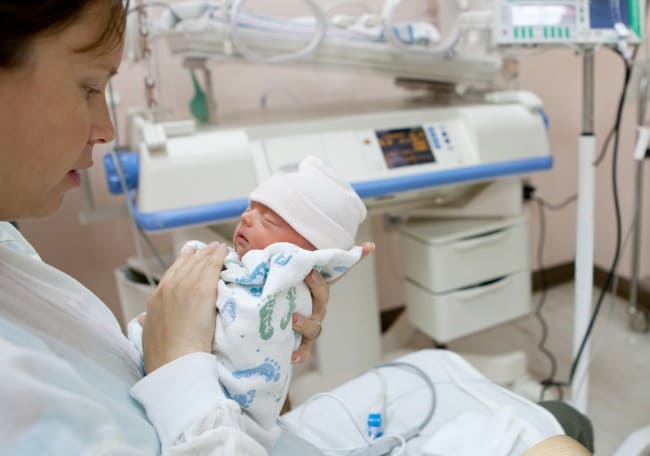Presentaciones neonatales de trastornos metabólicos

1. Saudubray JM, Sedel F, Walter JH. Clinical approach to treatable inborn metabolic diseases: an introduction. J Inherit Metab Dis. 2006;29(2-3):261–274
2. Saudubray JM, van den Berghe G, Walter JH. Inborn Metabolic Diseases: Diagnosis and Treatment. 5th ed. New York, NY: Springer; 2012
3. Kruszka P, Regier D. Inborn errors of metabolism: from preconception to adulthood. Am Fam Physician. 2019;99(1):25–32
4. Wichser J, Kazemi H. Ammonia and ventilation: site and mechanism of action. Respir Physiol. 1974;20(3):393–406
5. James IM, MacDonnell L, Xanalatos C. Effect of ammonium salts on brain metabolism. J Neurol Neurosurg Psychiatry. 1974;37(8):948–953
6. Manoli I, Sloan JL, Venditti CP. Isolated methylmalonic acidemia. Gene Reviews. Available at https://www.ncbi.nlm.nih.gov/books/NBK1231/. Accessed June 25, 2020
7. Shchelochkov OA, Carrillo N, Venditti C. Propionic acidemia. Gene Reviews. Available at: https://www.ncbi.nlm.nih.gov/books/NBK92946/. Accessed June 25, 2020
8. Chandler RJ, Zerfas PM, Shanske S, et al. Mitochondrial dysfunction in mut methylmalonic acidemia. FASEB J. 2009;23(4):1252–1261
9. Manoli I, Sysol JR, Li L, et al. Targeting proximal tubule mitochondrial dysfunction attenuates the renal disease of methylmalonic acidemia. Proc Natl Acad Sci USA. 2013;110(33):13552–13557
10. Wilnai Y, Enns GM, Niemi AK, Higgins J, Vogel H. Abnormal hepatocellular mitochondria in methylmalonic acidemia. Ultrastruct Pathol. 2014;38(5):309–314
11. Niemi AK, Enns GM. Pharmacology review: sodium phenylacetate and sodium benzoate in the treatment of neonatal hyperammonemia. Neoreviews. 2006;7(9):e486–e495 doi: 10.1542/neo.7-9-e486
12. Batshaw ML, MacArthur RB, Tuchman M. Alternative pathway therapy for urea cycle disorders: twenty years later. J Pediatr. 2001;138(1 suppl):S46–S55
13. Häberle J, Burlina A, Chakrapani A, et al. Suggested guidelines for the diagnosis and management of urea cycle disorders: first revision. J Inherit Metab Dis. 2019;42(6):1192–1230
14. Ah Mew N, Simpson KL, Gropman AL, Lanpher PBC, Chapman KA, Summar ML. Urea cycle disorders overview. Gene Reviews.Available at: https://www.ncbi.nlm.nih.gov/books/NBK1217/. Accessed June 25, 2020
15. Bellini C, Hennekam RC, Fulcheri E, et al. Etiology of non immune hydrops fetalis: a systematic review. Am J Med Genet A. 2009;149A(5):844–851
16. Bellini C, Donarini G, Paladini D, et al. Etiology of non-immune hydrops fetalis: An update. Am J Med Genet A. 2015;167A(5):1082–1088
17. Sudrié-Arnaud B, Marguet F, Patrier S, et al. Metabolic causes of non immune hydrops fetalis: A next-generation sequencing panel as a first-line investigation. Clin Chim Acta. 2018;481:1–8
18. Enns GM. Inborn errors of metabolism masquerading as hypoxicischemic encephalopathy. Neoreviews. 2005;6(12):e549–e558
19. Bonifacio SL, Glass HC, Vanderpluym J, et al. Perinatal events and early magnetic resonance imaging in therapeutic hypothermia. J Pediatr. 2011;158(3):360–365
20. Okereafor A, Allsop J, Counsell SJ, et al. Patterns of brain injury in neonates exposed to perinatal sentinel events. Pediatrics. 2008;121(5):906–914
21. Sánchez Fernández I, Morales-Quezada JL, Law S, Kim P. Prognostic value of brain Magnetic Resonance Imaging in neonatal hypoxic-ischemic encephalopathy: a meta-analysis. J Child Neurol. 2017;32(13):1065–1073
22. Glass HC, Shellhaas RA, Wusthoff CJ, et al; Neonatal Seizure Registry Study Group. contemporary profile of seizures in neonates: a prospective cohort study. J Pediatr. 2016;174:98–103.e1
23. Weeke LC, Groenendaal F, Toet MC, et al. The aetiology of neonatal seizures and the diagnostic contribution of neonatal cerebral magnetic resonance imaging. Dev Med Child Neurol. 2015;57(3):248–256
24. Topcu M, Coskun T, Haliloglu G, Saatci I. Molybdenum cofactor deficiency: report of three cases presenting as hypoxic-ischemic encephalopathy. J Child Neurol. 2001;16(4):264–270
25. Yoganathan S, Sudhakar S, Thomas M, Kumar Dutta A, Danda S, Chandran M. Novel imaging finding and novel mutation in an infant with molybdenum cofactor deficiency, a mimicker of hypoxic-ischaemic encephalopathy. Iran J Child Neurol. 2018;12(2):107–112
26. Atwal PS, Scaglia F. Molybdenum cofactor deficiency. Mol Genet Metab. 2016;117(1):1–4
27. Schwahn BC, Van Spronsen FJ, Belaidi AA, et al. Efficacy and safety of cyclic pyranopterin monophosphate substitution in severe molybdenum cofactor deficiency type A: a prospective cohort study. Lancet. 2015;386(10007):1955–1963
28. El-Hattab AW. Serine biosynthesis and transport defects. Mol Genet Metab. 2016;118(3):153–159
29. von der Hagen M, Pivarcsi M, Liebe J, et al. Diagnostic approach to microcephaly in childhood: a two-center study and review of the literature. Dev Med Child Neurol. 2014;56(8):732–741
30. Biancheri R, Cerone R, Schiaffino MC, et al. Cobalamin (Cbl) C/D deficiency: clinical, neurophysiological and neuroradiologic findings in 14 cases. Neuropediatrics. 2001;32(1):14–22
31. Zhang K, Gao M, Wang G, et al. Hydrocephalus in cblC type methylmalonic acidemia. Metab Brain Dis. 2019;34(2):451–458
32. Sloan JL, Carrillo N, Adams D, Venditti CP. Disorders of intracellular cobalamin metabolism. Gene Reviews. Available at: https://www.ncbi.nlm.nih.gov/books/NBK1328/. Accessed June 25, 2020
33. Rajappa M,Goyal A, Kaur J. Inherited metabolic disorders involving the eye: a clinico-biochemical perspective. Eye (Lond). 2010;24(4):507–518
34. Lipshultz SE, Sleeper LA, Towbin JA, et al. The incidence of pediatric cardiomyopathy in two regions of the United States. N Engl J Med. 2003;348(17):1647–1655
35. Nugent AW, Daubeney PE, Chondros P, et al; National Australian Childhood Cardiomyopathy Study. The epidemiology of childhood cardiomyopathy in Australia. N Engl J Med. 2003;348(17):1639–1646
36. Leslie N, Bailey L. Pompe disease. Gene Reviews. Available at: https://www.ncbi.nlm.nih.gov/books/NBK1261/. Accessed June 25, 2020
37. Bonnet D, Martin D, de Lonlay P, et al. Arrhythmias and conduction defects as presenting symptoms of fatty acid oxidation disorders in children. Circulation. 1999;100(22):2248–2253
38. Longo N, Amat di San Filippo C, Pasquali M. Disorders of carnitine transport and the carnitine cycle. Am J Med Genet C Semin Med Genet. 2006;142C(2):77–85
39. Ogier de Baulny H, Schiff M, Dionisi-Vici C. Lysinuric protein intolerance (LPI): a multi organ disease by far more complex than a classic urea cycle disorder. Mol Genet Metab. 2012;106(1):12–17
40. Humbert M, Labrune P, Simonneau G. Severe pulmonary arterial hypertension in type 1 glycogen storage disease. Eur J Pediatr. 2002;161(suppl 1):S93–S96
41. Alam S, Lal BB. Metabolic liver diseases presenting as acute liver failure in children. Indian Pediatr. 2016;53(8):695–701
42. Hegarty R, Hadzic N, Gissen P, Dhawan A. Inherited metabolic disorders presenting as acute liver failure in newborns and young children: King’s College Hospital experience. Eur J Pediatr. 2015;174(10):1387–1392
Comentarios
Para ver los comentarios de sus colegas o para expresar su opinión debe ingresar con su cuenta de IntraMed.







